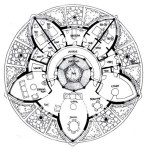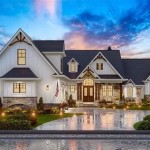Spanish Colonial Revival House Plans: Exploring an Enduring Architectural Legacy
Spanish Colonial Revival architecture emerged in the early 20th century as a resurgence of interest in Spanish colonial and mission-style buildings. These house plans exude an air of timeless elegance, combining elements of Old World charm with modern conveniences. Here are some essential aspects to consider when designing Spanish Colonial Revival house plans:
Symmetrical Facades
One defining characteristic of Spanish Colonial Revival houses is their symmetrical facades. The front elevation often features a central entrance flanked by identical windows on either side. This symmetrical arrangement creates a sense of balance and harmony.
Arched Doorways and Windows
Arched doorways and windows are another hallmark of Spanish Colonial Revival architecture. The arches can be simple or elaborate, adding a touch of architectural interest to the home. In some cases, doorways and windows may be trimmed with decorative elements such as wrought iron or carved wood.
Red Tile Roofs
Spanish Colonial Revival houses are typically topped with red tile roofs. The tiles, which are often made of fired clay or concrete, provide a durable and visually appealing roofing material. The rich red color adds a distinctive touch that complements the home's other architectural features.
Stucco Walls
Stucco is a plaster-like material that is commonly used in Spanish Colonial Revival houses. It provides a smooth, textured finish that can be painted or left in its natural state. Stucco walls are resistant to fire and water damage, making them a practical and attractive option.
Courtyards
Courtyards are an integral part of many Spanish Colonial Revival houses. These outdoor spaces provide a private and secluded area for relaxation and entertainment. They can be enclosed by walls or arcades and may feature fountains, patios, and gardens.
Wooden Beams and Ceilings
Exposed wooden beams and ceilings are another distinctive feature of Spanish Colonial Revival architecture. The beams, which are typically made of heavy timbers, add warmth and character to the home. They can be left exposed or painted to match the walls.
Decorative Ironwork
Wrought iron is commonly used in Spanish Colonial Revival houses for decorative purposes. It can be seen in railings, balconies, window grills, and other architectural elements. The intricate scrollwork and embellishments add a touch of elegance and sophistication to the home.
These are just a few of the essential aspects to consider when designing Spanish Colonial Revival house plans. By incorporating these elements, homeowners can create timeless and enchanting homes that evoke the charm and history of the past while providing modern comforts.

Encino House Plan Eclectic Monterey Spanish Revival Style American Residential Architecture Colonial Plans Homes Home

American Residential Architecture The El Pardo House Plans 1929 Home Builders Catalog Span In 2024 Spanish Style Homes Revival Vintage

Spanish Revival Style Home 1926 Universal Plan Service No 543 House Plans Portland Homes

1928 Home Builders Catalog Spanish Revival Style Homes Vintage House Plans

Villoresi Small Luxury House Plan Courtyard

1928 Home Builders Catalog Bungalow House Plans Spanish

Spanish Revival Entry 66026we Architectural Designs House Plans

Four Bedroom In Spanish Revival Style

Spanish Colonial Home Plans Sater Design Collection

1928 Home Builders Catalog Spanish Style Homes Vintage House Plans Modern








